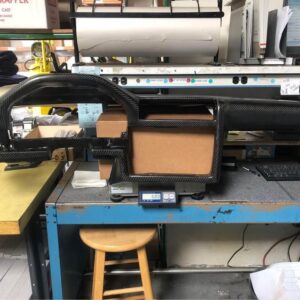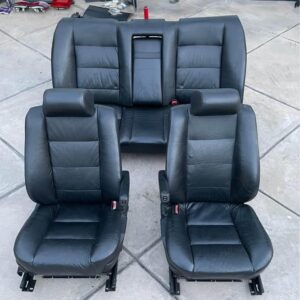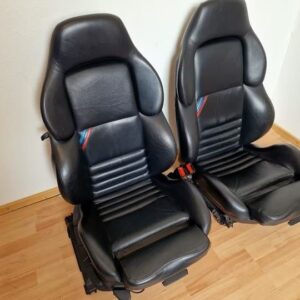The Enduring Comfort and Craftsmanship: A Deep Dive into BMW E46 Interior Seats
The BMW E46 series (1998-2006) remains a beloved classic for its driving dynamics, timeless design, and a cabin that prioritizes the driver experience. Central to this experience are the BMW E46 interior seats, a testament to German engineering that balances comfort, support, and a touch of luxury. Whether you’re a long-time owner, a potential buyer, or simply an automotive enthusiast, understanding the nuances of E46 seating is crucial.
Designed for the Drive: E46 Seat Philosophy
BMW’s philosophy with the E46 was clear: create a driver-focused cockpit. This extended directly to the seating, which was designed to provide excellent support during spirited driving while remaining comfortable for long journeys. Unlike some of its contemporaries, the E46 seats offered a variety of options that catered to different needs and budgets, all unified by a commitment to quality and ergonomics.
Key Types of BMW E46 Seats
The E46 typically came with a few distinct seat variations, each offering different levels of bolstering and adjustability:
- Standard/Base Seats:
- Description: These were the entry-level seats, often found in base model 318i or 320i variants. While more basic, they still offered good fundamental support.
- Materials: Commonly available in durable fabrics like “Sensatec” (BMW’s synthetic leatherette) or a variety of cloth patterns.
- Adjustments: Typically manual adjustments for fore/aft, recline, and height.
- Sport Seats (The Enthusiast’s Choice):
- Description: The “crown jewel” for many E46 enthusiasts, sport seats are instantly recognizable by their more aggressive side bolsters on both the seat cushion and backrest. These are designed to hold the occupant firmly in place during spirited cornering.
- Key Feature: An extendable thigh support (manual pull-out) is a hallmark of the sport seats, offering crucial under-thigh comfort for taller drivers and better support during long drives.
- Materials: Available across all premium material options, including leatherette, Montana leather, and Nappa leather.
- Adjustments: Could be manual or, more commonly, power-adjustable with options for lumbar support and memory settings.
- M3 Seats:
- Description: Exclusively found in the high-performance E46 M3, these seats took the sport seat design to another level with even more pronounced bolstering and unique design elements. They often featured specific stitching patterns or integrated headrests (though some M3s still used the adjustable headrest sport seats).
- Materials: Almost exclusively high-quality leather, often Nappa, with unique perforations or patterns. Some special editions offered Alcantara inserts.
- Adjustments: Predominantly power-adjustable with full range of motion, memory, and heating.
Material Options: A Touch of Class or Robust Durability
BMW offered a range of upholstery options for the E46, allowing buyers to tailor their interior to their preferences:
- Cloth/Fabric: Standard on base models, these were durable and breathable, offering a practical choice.
- Sensatec (Leatherette): BMW’s high-quality vinyl alternative to leather. It’s incredibly durable, easy to clean, and resistant to wear and tear, making it a popular choice for families.
- Montana Leather: The most common genuine leather option, offering a softer touch and premium feel compared to Sensatec. It ages gracefully, developing a unique patina over time.
- Nappa Leather: The top-tier leather option, often found in higher trim levels or M3s. Nappa is exceptionally soft, supple, and luxurious, though it requires more diligent care to maintain its pristine condition.
- Alcantara/Cloth Inserts: Sometimes combined with leather bolsters, Alcantara (a suede-like synthetic material) offered increased grip and a sporty aesthetic, commonly seen in performance-oriented models or optional packages.
Comfort Features & Adjustments
Beyond the basic types and materials, E46 seats could be optioned with desirable comfort features:
- Manual vs. Power Adjustment: While base models had manual levers, many E46s came with electric power seats, offering precise adjustments for recline, height, fore/aft, and tilt.
- Heated Seats: A highly sought-after option, providing warmth in colder climates.
- Lumbar Support: Electrically adjustable lumbar support was available, allowing drivers to fine-tune the curvature of the lower backrest for optimal comfort and reduced fatigue on long journeys.
- Memory Function: For vehicles with power seats, a memory function (usually for two or three drivers) allowed seat and mirror settings to be recalled at the touch of a button.
Common Considerations & Longevity
While well-built, E46 seats are now two decades old, and certain wear points are common:
- Driver’s Side Bolster Wear: Especially on sport seats, the outer bolster on the driver’s side often shows significant wear or tearing from ingress and egress. This is a tell-tale sign of a well-used E46.
- Creaking Frames: Over time, some seat frames can develop creaks or slight play, though often minor.
- Heated Seat Element Failure: The heating elements within the seat can sometimes fail, leading to non-functioning heat.
- Leather Cracking/Fading: Even well-maintained leather can show signs of aging, cracking, or fading from sun exposure.
Despite these common age-related issues, the core structure and ergonomic design of the BMW E46 interior seats remain robust. With proper care, or even a professional re-upholstering of worn sections, these seats continue to provide a comfortable and supportive environment, reinforcing the E46’s reputation as a true driver’s car. They are an integral part of what makes the E46 a timeless classic, blending luxury, sportiness, and an enduring commitment to the driving experience.





